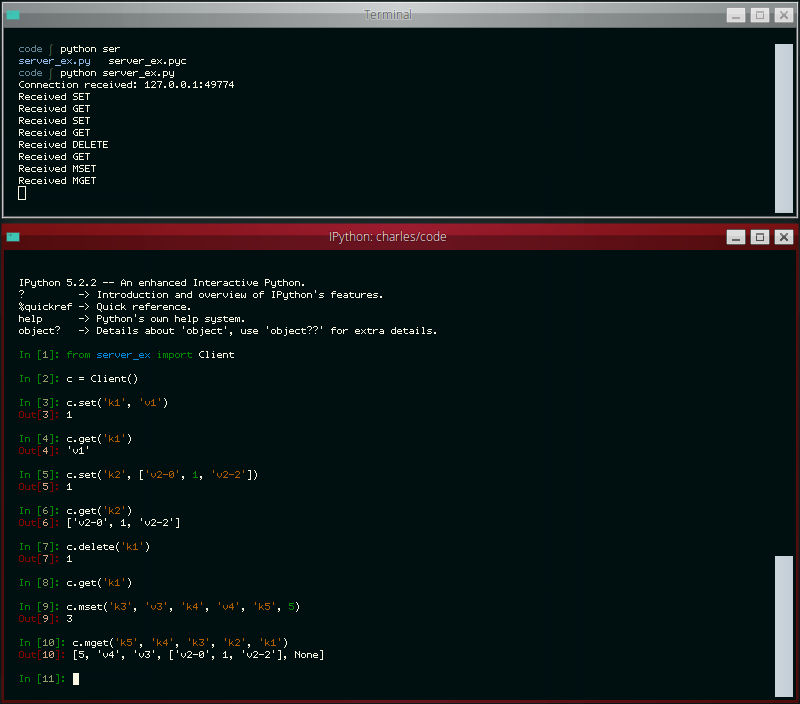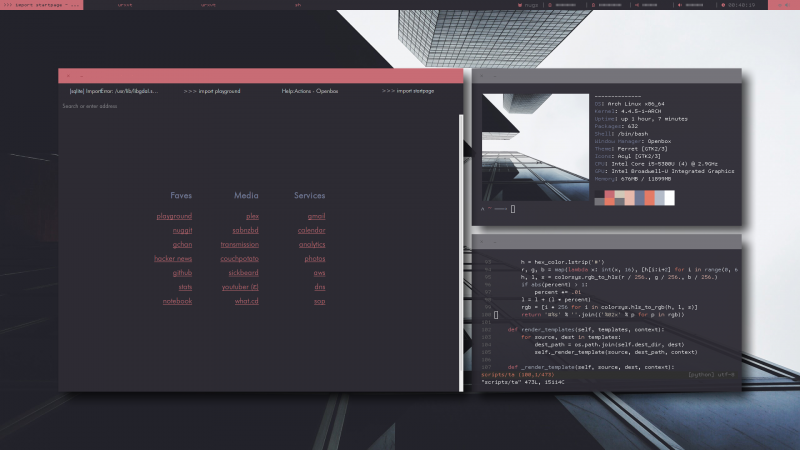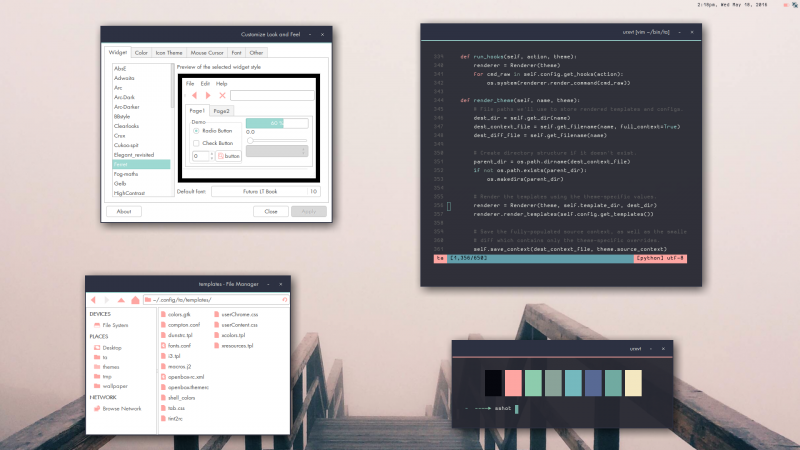Entries tagged with python
Kyoto Tycoon and Tokyo Tyrant with Python
I recently open-sourced a Python library for working with the networked key/value databases Kyoto Tycoon and Tokyo Tyrant. These databases sit atop Kyoto Cabinet and Tokyo Cabinet, respectively, and provide fast DBM implementations.
The Cabinet libraries expose a familiar key/value API backed by a number of different storage options, including persistent hash-tables and b-trees, as well as in-memory variants. A cabinet database can only be accessed by a single process at any given time, though they can be used safely in multi-threaded environments. For this reason, the author created an evented network layer that can expose these storage interfaces to multiple processes. These database servers are Kyoto Tycoon and Tokyo Tyrant, and in addition to providing a fast front-end to the underlying storage engines, they can add features like lua scripting, multi-master replication and LRU cache eviction.
Some scenarios in which you might find these databases useful:
- Memcached or Redis replacement. The LRU eviction provided by Kyoto Tycoon, combined with being scriptable with Lua, and backed with persistent storage, allows these databases to go beyond traditional key/value database roles.
- Time-series and event-logging. The B-Tree storage engine supports fast range scans and ordered key traversal, for rolling-up events, map/reduce workflows, and reporting.
- Full-text search, using the hash storage engine.
- Secondary indexes for external data-stores.
- Document database using lua tables in place of JSON objects.
Features of the kt library:
- Binary protocol support implemented as a C extension.
- Thread-safe and greenlet-safe.
- Simple and memorable APIs.
- Full-featured implementation of the protocols.
- Multiple serialization schemes, including JSON, msgpack and pickle.
If you're interested in trying out these fantastic databases with Python, the documentation for kt can be found here: http://kt-lib.readthedocs.io/en/latest/
Peewee 3.0 released
On Monday of this week I merged in the 3.0a branch of peewee, a lightweight Python ORM, marking the
official 3.0.0 release
of the project. Today as I'm writing this, the project is at 3.0.9, thanks to
so many helpful people submitting issues and bug reports. Although this was
pretty much a complete rewrite of the 2.x codebase, I have tried to maintain
backwards-compatibility for the public APIs.
In this post I'll discuss a bit about the motivation for the rewrite and some changes to the overall design of the library. If you're thinking about upgrading, check out the changes document and, if you are wondering about any specific APIs, take a spin through the rewritten (and much more thorough) API documentation.
SQLite Database Authorization and Access Control with Python
The Python standard library sqlite3 driver comes with a barely-documented hook for implementing basic authorization for SQLite databases. Using this hook, it is possible to register a callback that signals, via a return value, what data can be accessed by a connection.
SQLite databases are embedded in the same process as your application, so there is no master server process to act as a gatekeeper for the data stored in your database. Additionally, SQLite database files are readable by anyone with access to the database file itself (unless you are using an encryption library like sqlcipher or sqleet). Restricting access to a SQLite database, once a connection has been opened, is only possible through the use of an authorizer callback.
SQLite provides very granular settings for controlling access, along with two failure modes. Taken together, I think you'll be impressed by the degree of control that is possible.
Write your own miniature Redis with Python
The other day the idea occurred to me that it would be neat to write a simple Redis-like database server. While I've had plenty of experience with WSGI applications, a database server presented a novel challenge and proved to be a nice practical way of learning how to work with sockets in Python. In this post I'll share what I learned along the way.
The goal of my project was to write a simple server that I could use with a task queue project of mine called huey. Huey uses Redis as the default storage engine for tracking enqueued jobs, results of finished jobs, and other things. For the purposes of this post, I've reduced the scope of the original project even further so as not to muddy the waters with code you could very easily write yourself, but if you're curious, you can check out the end result here (documentation).
The server we'll be building will be able to respond to the following commands:
- GET
<key> - SET
<key><value> - DELETE
<key> - FLUSH
- MGET
<key1>...<keyn> - MSET
<key1><value1>...<keyn><valuen>
We'll support the following data-types as well:
- Strings and Binary Data
- Numbers
- NULL
- Arrays (which may be nested)
- Dictionaries (which may be nested)
- Error messages
LSM Key/Value Storage in SQLite3
Several months ago I was delighted to see a new extension appear in the SQLite source tree. The lsm1 extension is based on the LSM key/value database developed as an experimental storage engine for the now-defunct SQLite4 project. Since development has stopped on SQLite4 for the forseeable future, I was happy to see this technology being folded into SQLite3 and was curious to see what the SQLite developers had in mind for this library.
The SQLite4 LSM captured my interest several years ago as it seemed like a viable alternative to some of the other embedded key/value databases floating around (LevelDB, BerkeleyDB, etc), and I went so far as to write a set of Python bindings for the library. As a storage engine, it seems to offer stable performance, with fast reads of key ranges and fast-ish writes, though random reads may be slower than the usual SQLite3 btree. Like SQLite3, the LSM database supports a single-writer/multiple-reader transactional concurrency model, as well as nested transaction support.
The LSM implementation in SQLite3 is essentially the same as that in SQLite4, plus some additional bugfixes and performance improvements. Crucially, the SQLite3 implementation comes with a standalone extension that exposes the storage engine as a virtual table. The rest of this post will deal with the virtual table, its implementation, and how to use it.
Ditching the Task Queue for Gevent
Task queues are frequently deployed alongside websites to do background processing outside the normal request/response cycle. In the past I've used them for things like sending emails, generating thumbnails, warming caches, or periodically fetching remote resources. By pushing that work out of the request/response cycle, you can increase the throughput (and responsiveness) of your web application.
Depending on your workload, though, it may be possible to move your task processing into the same process as your web server. In this post I'll describe how I did just that using gevent, though the technique would probably work well with a number of different WSGI servers.
Going Fast with SQLite and Python
In this post I'd like to share with you some techniques for effectively working with SQLite using Python. SQLite is a capable library, providing an in-process relational database for efficient storage of small-to-medium-sized data sets. It supports most of the common features of SQL with few exceptions. Best of all, most Python users do not need to install anything to get started working with SQLite, as the standard library in most distributions ships with the sqlite3 module.
Multi-threaded SQLite without the OperationalErrors
SQLite's write lock and pysqlite's clunky transaction state-machine are a toxic combination for multi-threaded applications. Unless you are very diligent about keeping your write transactions as short as possible, you can easily wind up with one thread accidentally holding a write transaction open for an unnecessarily long time. Threads that are waiting to write will then have a much greater likelihood of timing out while waiting for the lock, giving the illusion of poor performance.
In this post I'd like to share a very effective technique for performing writes to a SQLite database from multiple threads.
Optimistic locking in Peewee ORM
In this post I'll share a simple code snippet you can use to perform optimistic locking when updating model instances. I've intentionally avoided providing an implementation for this in peewee, because I don't believe it will be easy to find a one-size-fits-all approach to versioning and conflict resolution. I've updated the documentation to include the sample implementation provided here, however.
Suffering for fashion: a glimpse into my Linux theming toolchain
My desktop at the time of writing.
Here it is a couple months later.
It's been over 2 years since I wrote about the tooling I use to theme my desktop, so I thought I'd post about my current scripts...







